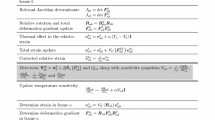This article describes a method for modeling the propagation of cracks on any 3D surface. This method allows almost any type of cracks on any type of triangulated 3D object. Our model´s main advantage is that it proposes a semi-physical solution, making it both user controllable and easily extensible. We first introduce the general development of cracks. We then present our original model of spectrum stress, followed by a description of the mutual interaction between cracks and stresses. Then, we describe special rendering techniques including the multi-thickness anti-aliasing linked-segment method and the crack mirror special effect. The final section presents intermediate graphical results that review the entire model as well as a set of different crack patterns using various types of material such as concrete, ceramic, mud, and glaze.
Similar content being viewed by others
Author information
Authors and Affiliations
Rights and permissions
About this article
Cite this article
Gobron, S., Chiba, N. Crack pattern simulation based on 3D surface cellular automata. Visual Comp 17, 287–309 (2001). https://doi.org/10.1007/s003710100099
Issue Date:
DOI: https://doi.org/10.1007/s003710100099




